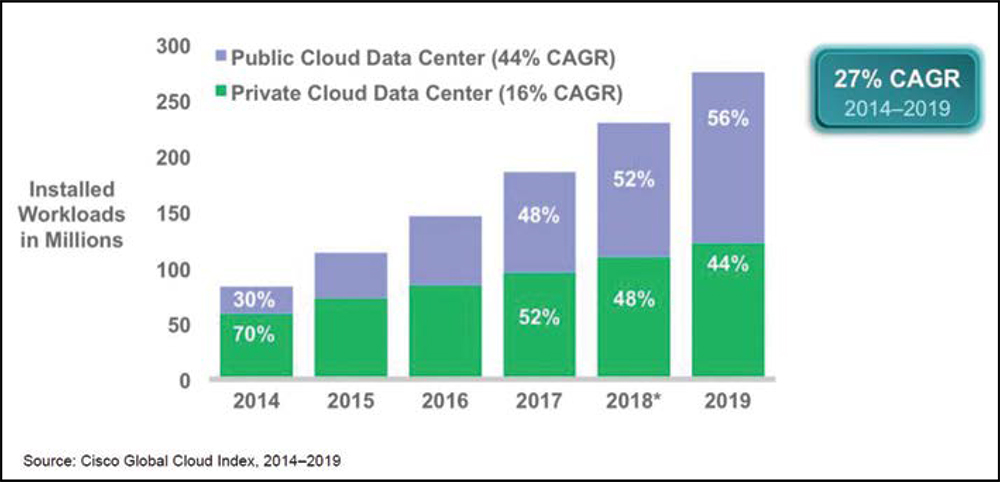The Future of Media Infrastructure
There is little doubt that compute virtualization has changed the data center forever. It has led the way for software-defined resources: compute, storage and networking. The cloud is the biggest beneficiary of software-defined concepts and the trickle-down effect is influencing how media systems are designed and implemented.
This article will review three trends important to media system designers related to the “global data center.” This term describes private/local, hybrid and public clouds. The themes are: cloud progress, virtualization maturity and service workloads. This article highlights some conclusions from the “Cisco Global Cloud Index: Forecast and Methodology 2914–2019” report and from other research sources.
CLOUD PROGRESS
The five basic value propositions of the public cloud (and private to an extent) are:
• On-demand services
• Network access
• Resource pooling
• Agility of usage
• Pay by use
Each provides a value not provided by the traditional data center. Infrastructure-as-a-Service (IaaS) is the king of cloud offerings. IaaS adoption has been slow in some quarters, especially for media operations. There are reasons for this, not the least is user “trust” in the cloud service provider (CSP). Will they lose my data? Will the data be secure? Will they be in business in 10 years? In 20?
One factor in CSP trust is the ability to achieve growth with continued profit. Profitable companies have “staying power” and this creates trust and confidence by end users. Consider, Amazon Web Services (AWS) the largest of the CSPs, generated $2.56 billion in revenue during the first quarter of 2016 (~$10.24 billion/year run rate), up 64 percent compared to a year earlier with operating income of $604 million. Morgan Stanley predicts Microsoft cloud will be 30 percent of its revenue by 2018. In 2016, spending on public IaaS is forecast to reach $38 billion, growing to $173 billion in 2026 (Statista 2016). The cloud is here to stay and so are the most successful CSPs.
It is interesting that Netflix, Hertz, Intuit, Juniper and many other companies have their business operations “all in” the cloud. Much of General Electric does as well. This is a strong confirmation that these companies put long-term trust in their selected CSPs.
Media companies have announced projects, too, such as Disney’s announcement last year to move its ABC network control room and playout operations to the cloud. Bottom line, the cloud is ready for the media business even if only in portions. Filebased operations are more cloud-friendly than real-time studio operations in 2016. Proxy video resolutions, compared to uncompressed, are more aligned with cloud-based workflows. There are many factors, of course, but some designers are finding value in moving relevant media operations to the cloud.
Important, too, is vendor product support. If vendors don’t test and support their software in a cloud environment, end users will be reluctant to purchase. If you attend the NAB Show or IBC or whenever you speak to vendors, ask about their cloud support for products. Fortunately, more and more vendors appreciate the need. If not, demand it.
VIRTUALIZATION MATURITY
By 2019, more than 86 percent of all workloads will be processed in cloud data centers. A workload is a unit of measure describing applications that range from simple Software-as-a-Service (SaaS) apps to large compute-bound jobs to database applications. This means that only 14 percent of workloads will be running in traditional data centers. The old adage “A rising tide lifts all boats” applies to media system operations, too.
Compute virtualization allows dynamic deployment of workloads in a cloud environment. A related means to share compute resources by different workloads is called “containerization.” To get a handle on the differences and advantages see the Cloudspotters Journal article “Understanding Virtualization and Containers,” http://goo.gl/jrorHa.
Public cloud is growing faster than private cloud in terms of workload adoption. Many businesses want the resource agility that is offered by public clouds only. Plus, the pay-by-use model may not be available for private clouds. However, if uncompressed video data rates are used, then private has the edge for now. Security is always a concern, but in reality, security is a shared responsibility, part end user and part CSP. Mature developers know that cloud security can be excellent and the worry is often misplaced.

Fig. 1: Graphic shows a projection of the split between public and private cloud use. Fig. 1 shows a projection of the split between public and private cloud use. Note that public use is growing about three times faster than private, and in 2019, 155 million workloads will be executed in the public cloud.
Many media systems will use the hybrid cloud model where the most data intensive computing and storage will be done in-house likely using a private cloud and all other media processing executed in a public cloud setting. Very few systems will only be private-cloud only without a link to public SaaS, storage, API services or compute.
On the private-cloud front, companies such as EMC/Dell, HP, IBM, Cisco, NetApp, Nutanix, SimpliVity and others offer converged systems. The converged infrastructure (CI) vendors offer integrated compute, storage and networking in a racked, pretested configuration managed with “one pane of glass.” At the leading edge of convergence is the hyper-converged infrastructure (HCI). This paradigm relies on individual nodes with both storage and compute networked in a cluster (from a few to thousands of nodes) to create a “web-scale” architecture for executing workloads. CI and HCI are very friendly to on-premise media operations.
SERVICE WORKLOADS USING SAAS
SaaS apps are a huge disrupter to the current installed desktop (or workstation) model. Does any user really want to worry about updating applications and geo-distributed access to apps/data? SaaS provides automatic, invisible updates with universal access via a browser. It’s true that some high-end video editors, color correctors and related apps do need local processing due to elevated video data rates. But the majority of media apps can be SaaS-based and end users should be on the lookout for vendors that support this model.
The Cisco Global Cloud Index report predicts that public SaaS apps will grow at a 39-percent cumulative annual growth rate (CAGR) until 2019. Desktop apps have advantages for sure, but the SaaS model is so very compelling as a replacement.
CATCH THE WAVE
Both the private and public cloud will be a major part of many new or remodeled media facilities. Create a “cloud first” strategy—consider the cloud first; if not a fit, then look to alternatives. Stay educated in this area else you risk missing the wave that is sure to be our future.
Al Kovalick is the founder of Media Systems Consulting in Silicon Valley. He is the author of “Video Systems in an IT Environment (2nd ed.).” He is a frequent speaker at industry events and a SMPTE Fellow. For a complete bio and contact information, visitwww.theAVITbook.com.
Get the TV Tech Newsletter
The professional video industry's #1 source for news, trends and product and tech information. Sign up below.

